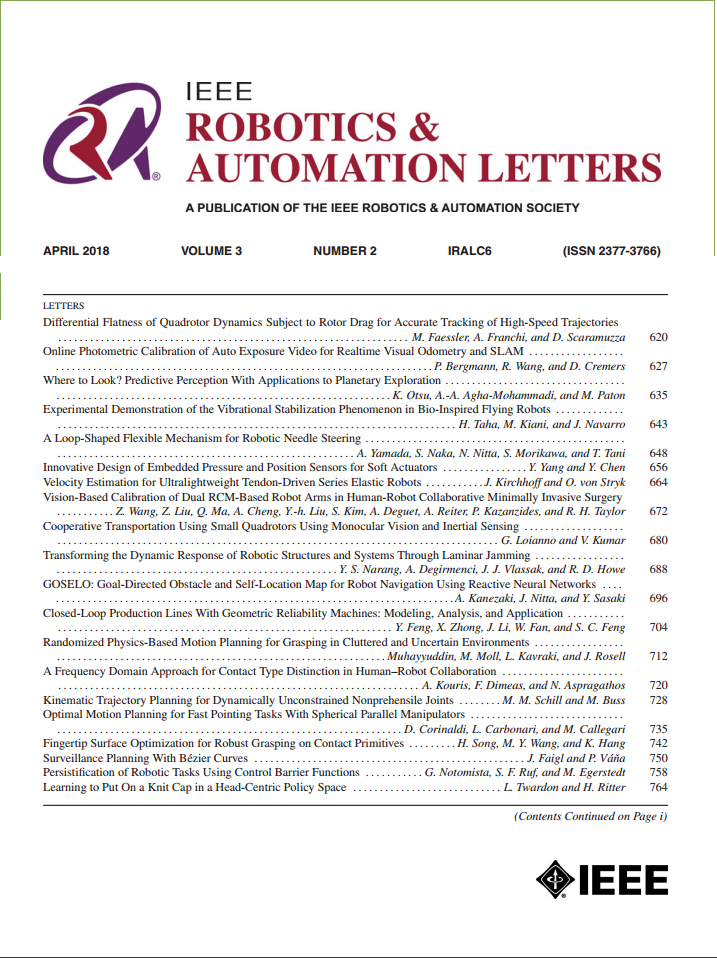在人机交互中保持安全和跟踪性能的无效空间遵从方法
IF 4.6
2区 计算机科学
Q2 ROBOTICS
引用次数: 0
摘要
近年来,人机交互(HRI)的安全性已成为开发机器人的重点。阻抗控制是协作任务中交互控制的一种典型方法。然而,这种控制方法有两个主要的局限性:1)末端执行器(EE)有限的顺应性,以适应未知的物理相互作用,2)机器人身体无法适应未知的物理相互作用。在这项工作中,我们提出了一种解决这些缺点的方法。为了在不影响主要任务跟踪性能的前提下,增强机器人的交互能力,我们引入了一种改进的笛卡尔阻抗控制方法,并结合了基于动力系统(DS)的运动发生器。这种方法使人类同事能够与EE实时交互,例如,工具切换,之后机器人顺从地恢复其任务。此外,结合一种新的零空间阻抗控制方法,使机器人身体在响应交互时表现出顺从的行为,避免意外接触造成的严重伤害,同时减轻对主要任务跟踪性能的影响。最后,通过KUKA LWR IV+ 7自由度机器人的综合对比实验,证明了系统的无源性,并验证了所提出的方法。本文章由计算机程序翻译,如有差异,请以英文原文为准。
A Null Space Compliance Approach for Maintaining Safety and Tracking Performance in Human-Robot Interactions
In recent years, the focus on developing robot manipulators has shifted towards prioritizing safety in Human-Robot Interaction (HRI). Impedance control is a typical approach for interaction control in collaboration tasks. However, such a control approach has two main limitations: 1) the end-effector (EE)’s limited compliance to adapt to unknown physical interactions, and 2) inability of the robot body to compliantly adapt to unknown physical interactions. In this work, we present an approach to address these drawbacks. We introduce a modified Cartesian impedance control method combined with a Dynamical System (DS)-based motion generator, aimed at enhancing the interaction capability of the EE without compromising main task tracking performance. This approach enables human coworkers to interact with the EE on-the-fly, e.g. tool changeover, after which the robot compliantly resumes its task. Additionally, combining with a new null space impedance control method enables the robot body to exhibit compliant behaviour in response to interactions, avoiding serious injuries from accidental contact while mitigating the impact on main task tracking performance. Finally, we prove the passivity of the system and validate the proposed approach through comprehensive comparative experiments on a 7 Degree-of-Freedom (DOF) KUKA LWR IV+ robot.
求助全文
通过发布文献求助,成功后即可免费获取论文全文。
去求助
来源期刊

IEEE Robotics and Automation Letters
Computer Science-Computer Science Applications
CiteScore
9.60
自引率
15.40%
发文量
1428
期刊介绍:
The scope of this journal is to publish peer-reviewed articles that provide a timely and concise account of innovative research ideas and application results, reporting significant theoretical findings and application case studies in areas of robotics and automation.
 求助内容:
求助内容: 应助结果提醒方式:
应助结果提醒方式:


